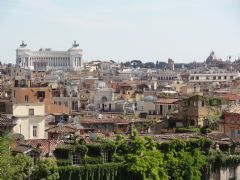After a busy couple of days with the athletes since arriving in Rome for the Diamond League meet that took place on Thursday, I have been taking the opportunity to unwind & enjoy the sun in the Eternal City for the weekend.
It’s been a while since I last spent time in Rome but the architectural magnificence never fails to impress…neither for that matter, does the ice cream! In fact after 3 days, I feel I have followed enough advice & sampled the offerings of enough gelateri to reach the conclusion that the top 3 places to visit for frozen feasts are:
1. Grom (Piazza Navona 1, angolo Via Agonale) – quite simply the best dark chocolate ice cream that has passed my lips & an incredible raspberry sorbet too…well worth enduring the queue for!
2. I Caruso (Via Collina, 13-15) – a very creamy almond ice that complemented the commendable strawberry sorbet
3. Ciampini (Piazza Trinita dei Monti) – a notable pistachio offering & interesting chestnut recipe too, although the service was the least remarkable
However, despite the poor service, I will be heading to Ciampini again tonight as I really want to try the sour cherry flavour, which had run out yesterday. However, whilst my excessive ice cream consumption might be a cause for concern, I am keeping my guilt in check after reading about the latest research regarding tart cherries.
Presenting at the American College of Sports Medicine (ACSM) Annual Conference in San Francisco last week, researchers from the Oregon Health & Science University presented their study indicating that tart cherries may help reduce chronic inflammation, whilst suggesting that the fruits have the “highest anti-inflammatory content of any food”.
The study, conducted by Sleigh et al, investigated the effect of drinking the tart cherry juice twice a day over a 3-week period, in a population of 20 women aged 40 – 70 suffering from inflammatory osteoarthritis. The results showed significant reductions in important inflammatory markers, especially in the women demonstrating the highest inflammatory levels at the start of the study.
Sleigh, A.E., Kuehl, K.S. & Elliot, D.L. (2012). Efficacy of tart cherry juice to reduce inflammation among patients with osteoarthritis. Am Col of Sports Med (Annual Meeting, 30 May).
I first was aware of the anti-oxidant & anti-inflammatory benefits of tart cherry juice when several of the rugby players, with whom I worked for Edinburgh & Scotland were advised to drink it during the 2007 season, following research published by Connolly et al in 2006. In fact Kuehl’s previous research also raised awareness of the potential benefits to the athletic population as it demonstrated that people who drank cherry juice whilst undertaking endurance running training reported significantly less pain after exercise than the control group that didn’t.
Since these studies were published, further support for the anti-inflammatory & anti-oxidant effects of tart cherry juice when ingested by endurance athletes has been provided through research published in the Scandinavian Journal of Medicine & Science in Sports by Howatson et al in 2010 & following strength training through a study published in Medicine & Science in Sports & Exercise by Bowtell et al in 2011.
Another advocate of the tart cherry juice, is Leslie Bonci, the Director of Sports Nutrition based at University of Pittsburgh Medical Center (UPMC), whom I visited whilst working for the Pittsburgh Steelers back in 2010. Leslie included the cherry juice in the diet plans of several of the American footballers because of the anti-inflammatory benefits that had been published in the nutrition journals.
Seeram et al (2001) identified the antioxidant compounds present in tart cherry juice as cyanidin glycosides, which are present in several super fruits, also providing the colourful pigments & Cush (2007) observed the antioxidant capacity provide anti-inflammatory effects comparable to those achieved by some familiar pain relieving medications.
Cush, J.J. (2007). Pilot Study on Tart Cherry & Osteoarthritis of the Knees. Baylor Research Institute.
So, whilst you read your way through those references, I'm back off out into the sunshine to go & top up on my anti-oxidants!!!

